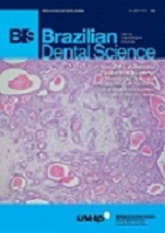Influence of adhesive system in bond strength of fiber glass posts to radicular dentin using dual cure resin cement
DOI:
https://doi.org/10.14295/bds.2014.v17i1.932Resumo
The purpose of this study was to evaluate the bond strength between root dentin and glass fiber posts cemented with dual cure resinous cement associated with the conventional and self-etching adhesive systems. Twenty-four single-rooted human teeth were selected, and the crowns were removed at the cement enamel junction. The roots received biomechanical preparation and obturation followed by the intraradicular preparation compatible with a drill diameter of the glass fiber posts. The roots were divided into two groups, according to cementation protocol (n-12): Group 1 - etched with 37% phosphoric acid for 30 seconds, total-etch adhesive system Single Bond (3M ESPE) and Enforce resinous cement (Dentsply); Group 2 – self-etch adhesive system One Up Bond F (Tokuyama) and Enforce resinous cement (Dentsply). After the posts cementation, the roots were kept at 370 C for one week, and submitted to pull out test on the universal testing machine Emic to a traction speed of 1 mm/min. Data in MPa were submitted to the statistical t-test (5%). The t-test showed significant differences between the two groups (p=0.003). The average values in MPa (±standard-deviation) were: Group 1: 5.28(±3.25), Group 2: 10.05(±3.78). Enforce associated with the self-etch adhesive system One Up Bond F showed significantly higher bond strength values than Group 1 - Enforce associated with the total-etch adhesive system Single Bond.
Downloads
Downloads
Arquivos adicionais
Publicado
Como Citar
Edição
Seção
Licença
TRANSFERÊNCIA DE DIREITOS AUTORAIS E DECLARAÇÃO DE RESPONSABILIDADE
Toda a propriedade de direitos autorais do artigo "____________________________________________________________________" é transferido do autor(es) para a CIÊNCIA ODONTOLÓGICA BRASILEIRA, no caso do trabalho ser publicado. O artigo não foi publicado em outro lugar e não foi submetido simultaneamente para publicação em outra revista.
Vimos por meio deste, atestar que trabalho é original e não apresenta dados manipulados, fraude ou plágio. Fizemos contribuição científica significativa para o estudo e estamos cientes dos dados apresentados e de acordo com a versão final do artigo. Assumimos total responsabilidade pelos aspectos éticos do estudo.
Este texto deve ser impresso e assinado por todos os autores. A versão digitalizada deverá ser apresentada como arquivo suplementar durante o processo de submissão.




























